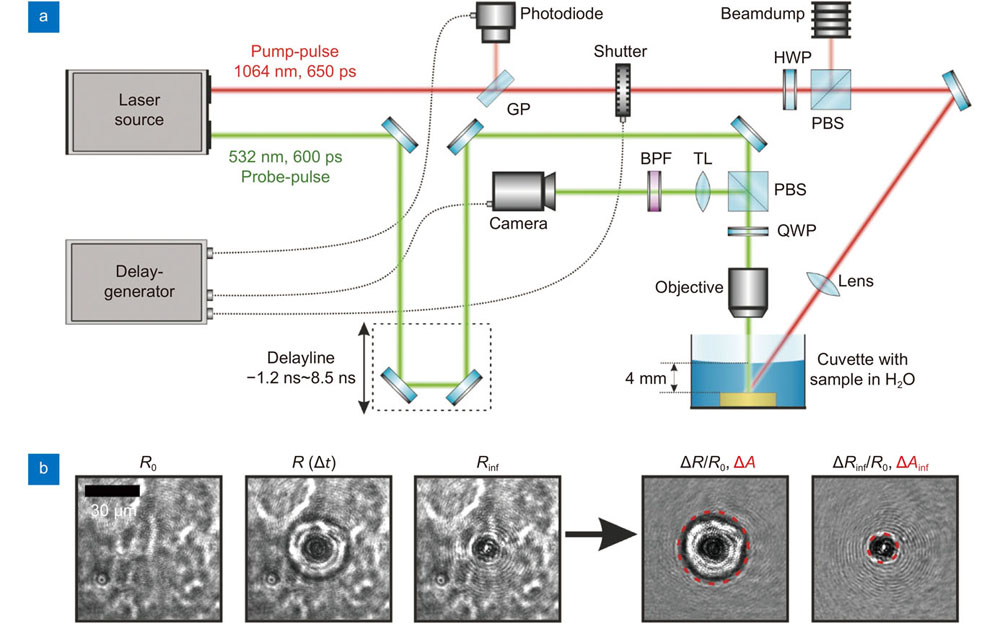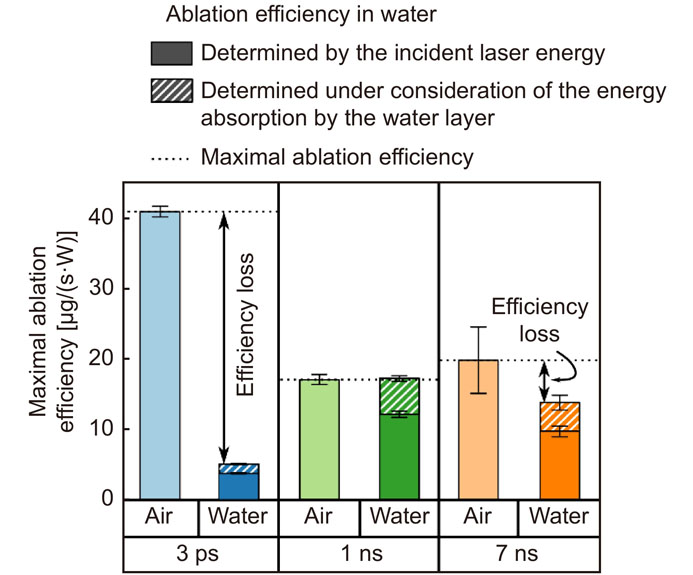Sarah Dittrich, Maximilian Spellauge, Stephan Barcikowski, Heinz P. Huber, Bilal Gökce. Time resolved studies reveal the origin of the unparalleled high efficiency of one nanosecond laser ablation in liquids[J]. Opto-Electronic Advances, 2022, 5(6): 210053
Search by keywords or author
- Opto-Electronic Advances
- Vol. 5, Issue 6, 210053 (2022)

Fig. 1. (a ) Pump-probe microscopy setup for the ablation in water. For the analysis of the ablation process in air, no cuvette is used, otherwise the setup is the same. (b ) Image post processing of the three recorded images. The images of the pristine surface (R0), during the ablation process (R(Δt)) and after the ablation process has finished (Rinf) were used to calculate the transient (ΔR/R0) and final state (ΔRinf/R0) relative reflectivity change. The red dashed circles mark the transient laser-modified area ΔA and the final laser-modified area ΔAinf.

Fig. 2. Maximal ablation efficiency for the ablation of gold in air (light-colored, solid bars) and water (dark-colored bars) for lasers of 3 ps (blue, ~2 J/cm² and 100 µJ/pulse), 1 ns (green, ~8 J/cm² and 130 µJ/pulse), and 7 ns (orange, ~13 J/cm² and 400 µJ) pulse duration with data from ref.10 where the ablation efficiency is calculated with the incident laser energy (dark-colored, solid bar) and under consideration of the linear energy extinction by the water layer (dark-colored, hatched bar). The error bars represent the statistical error.
Fig. 3. (a ) Exemplary microscopy images at different delay times are displayed . Time-dependent change in (b ) the relative reflectivity ΔR/R0 and (c ) the transient laser-modified area ΔA of the Au target surface for PPM in air (black open symbols) and water (blue open symbols) after irradiation with 650 ps pulses at 8 J/cm². The final laser-modified areas ΔAinf are depicted at the Δt labeled “inf” and the pump-pulses are indicated by red areas. The blue solid vertical line marks the characteristic Δt where ΔA exceeds its final state value ΔAinf.
Fig. 4. Transient laser-modified area ΔA for PPM of Ag (blue open squares) and Pt (blue solid triangles) targets at 8 J/cm2. The final state values of the laser-modified area are depicted at the Δt labeled “inf” and the pump-pulse is indicated by a red area. Blue dashed and solid vertical lines mark the Δt where ΔA exceeds the final state value for Ag and Pt, respectively.

Set citation alerts for the article
Please enter your email address



